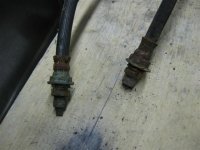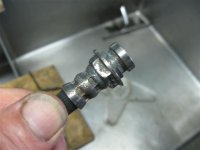Bill D
Diamond
- Joined
- Apr 1, 2004
- Location
- Modesto, CA USA
Evaporust rust remover costs about $25 per gallon so I am trying to make my own. From what I have read it is mainly EDTA with some acid(maybe citric acid) or lye to keep the ph around 6-7. I bought one pound of EDTA powder for about $12 delivered from ebay. I put about one teaspoon in a jar with 1.5 cups of tap water. Added a little vinegar to adjust the PH. I think I read the meter wrong and should have added lye.
Threw in a rusty nail and saw no change for several days. Last night I took out the nail and it looks like raw gray iron, no rust at all. So I am happy with my first try. Shop is running 70-80 degrees day./night right now.
My research says one pound of EDTA will remove about one pound of rust. I would think rust is about half the density of solid iron with it's sponge like texture. Solid iron is roughly four cubic inches per pound.
Bill D.
Threw in a rusty nail and saw no change for several days. Last night I took out the nail and it looks like raw gray iron, no rust at all. So I am happy with my first try. Shop is running 70-80 degrees day./night right now.
My research says one pound of EDTA will remove about one pound of rust. I would think rust is about half the density of solid iron with it's sponge like texture. Solid iron is roughly four cubic inches per pound.
Bill D.






